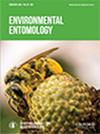寄主植物对斑灯蝇(半翅目:Fulgoridae)若虫存活和发育的影响
IF 1.8
3区 农林科学
Q2 ENTOMOLOGY
引用次数: 0
摘要
斑潜蝇(Lycorma delicatula (White))是一种来自中国的入侵食蚜蝇,2014年首次在宾夕法尼亚州伯克斯县被发现,此后于2018年扩散到邻近各州,包括新泽西州。Lycorma delicatula是一种多食性物种,群集取食超过172种已知寄主。我们调查了主要寄主植物Ailanthus altissima(Miller)(无患子目:樗科)、Juglans nigra(L.)(椑科:椑属)、Acer rubrum(L.)(无患子目:无患子科)和Vitis vinifera(L.)(葡萄科:葡萄属)各龄期的发育情况,以阐明整个季节的潜在寄主使用情况,并确定监测工作的目标。我们的研究表明,不同寄主植物的存活率和若虫每个生命阶段所花费的时间都有显著差异。我们将寄主适宜性指数作为每种寄主植物和蛹的存活率和发育情况的函数,结果表明 A. altissima 和 J. nigra 适合所有 4 个蛹的寄主。葡萄树非常适合第一和第二龄若虫,但第三和第四龄若虫的指数较低,不过葡萄树的适宜性可能因葡萄品种和树龄而异。Lycorma delicatula若虫在A. rubrum的四个生命阶段中存活率最低,发育时间最长,尽管它是首选的产卵寄主。寄主对我们测量的第一和第二龄若虫的形态计量有显著影响。本文章由计算机程序翻译,如有差异,请以英文原文为准。
Effects of host plants on spotted lanternfly (Hemiptera: Fulgoridae) nymphal survival and development
Spotted lanternfly, Lycorma delicatula (White), is an invasive planthopper from China, which was first detected in Berks County, PA, in 2014 and has since spread to adjacent states including New Jersey in 2018. Lycorma delicatula is a polyphagous species that gregariously feeds on over 172 known hosts. We investigated development on key host plants Ailanthus altissima (Miller) (Sapindales: Simaroubaceae), Juglans nigra (L.) (Fagales: Juglandaceae), Acer rubrum (L.) (Sapindales: Sapindaceae), and Vitis vinifera (L.) (Vitales: Vitaceae) for each instar to elucidate potential host use throughout the season and target monitoring efforts. Our study indicated significant differences in survivorship and time spent in each nymphal life stage between host plants. We applied a host suitability index as a function of survivorship and development for each host plant and instar, which indicated A. altissima and J. nigra as suitable hosts for all 4 nymphal instars. Vitis vinifera was highly suitable for first and second instars but had low indices for the third and fourth instars, although suitability of V. vinifera may have varied based on variety and age of the vine. Lycorma delicatula nymphs had the lowest survivorship and longest development time on A. rubrum across all 4 life stages, despite this being a preferred oviposition host. Host had a significant effect on the morphometrics we measured within the first and second instars.
求助全文
通过发布文献求助,成功后即可免费获取论文全文。
去求助
来源期刊

Environmental Entomology
生物-昆虫学
CiteScore
3.90
自引率
5.90%
发文量
97
审稿时长
3-8 weeks
期刊介绍:
Environmental Entomology is published bimonthly in February, April, June, August, October, and December. The journal publishes reports on the interaction of insects with the biological, chemical, and physical aspects of their environment. In addition to research papers, Environmental Entomology publishes Reviews, interpretive articles in a Forum section, and Letters to the Editor.
 求助内容:
求助内容: 应助结果提醒方式:
应助结果提醒方式:


